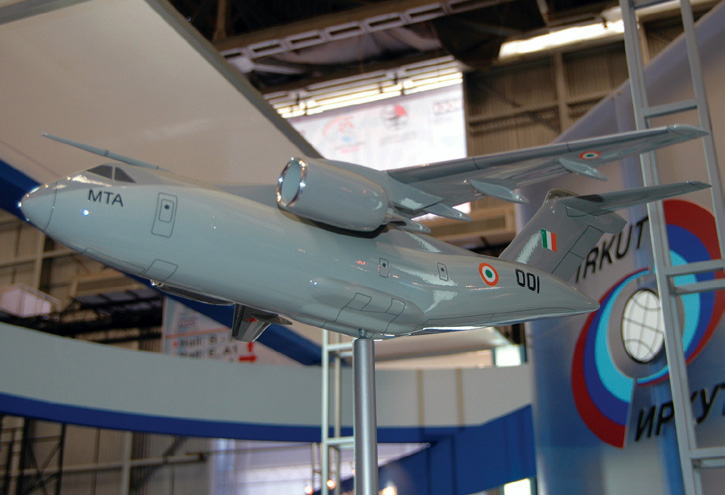SOURCE: AFI


India’s defense forces rely heavily on their transport aircraft fleet to ensure rapid deployment of troops, equipment, and humanitarian aid across diverse terrains and in challenging conditions. The Indian Air Force (IAF) currently operates a fleet of aging Soviet-era Ilyushin Il-76 and Antonov An-32 aircraft, which have served as the backbone of its medium and heavy-lift capabilities for decades.
However, with these platforms nearing the end of their operational lives and facing maintenance challenges, the need for modern replacements is urgent. India stands at a crossroads where it can either procure foreign designs or invest in indigenous solutions.
The Il-76, inducted in the 1980s, is a heavy-lift strategic airlifter with a payload capacity of around 48 tonnes, while the An-32, operational since the 1980s, serves as a medium-lift tactical transporter with a payload of 6–7 tonnes. Both aircraft have played pivotal roles in military logistics, disaster relief, and high-altitude operations in regions like Ladakh and the Northeast. However, their age, coupled with dwindling spare parts availability—exacerbated by geopolitical tensions involving Russia and Ukraine—has led to declining serviceability rates. Modern threats also demand aircraft with better performance, stealth features, and interoperability with advanced systems, which these legacy platforms lack.
Procuring the designs of an MTA offers a strategic solution. An MTA, typically in the 18–30 tonne payload range, can bridge the gap between the Il-76 and An-32 by offering versatility for both medium and heavy-lift roles with modern avionics, fuel efficiency, and short takeoff and landing (STOL) capabilities. The IAF issued a Request for Information (RFI) in 2022 for such an aircraft, with contenders like the Airbus A400M, Lockheed Martin C-130J, and Embraer C-390 in consideration. Instead of outright procurement, India should negotiate to acquire the design rights and intellectual property of a suitable MTA platform. This approach would allow India to adapt the aircraft to its specific operational needs while serving as a foundation for further indigenous development.
Once the MTA design is procured, India can leverage its ongoing aero-engine programs—the high-thrust engine for the Advanced Medium Combat Aircraft (AMCA) and the Kaveri engine—to develop two distinct variants of the transport aircraft, tailored to replace the Il-76 and An-32 respectively. This dual-track approach would maximize self-reliance while addressing the diverse needs of the IAF.
The AMCA program, aimed at developing a fifth-generation stealth fighter, requires a high-thrust engine in the 110–130 kN range, likely to be developed in collaboration with international partners like Safran or Rolls-Royce. Once this engine matures, it can be adapted for a heavy-lift variant of the MTA to replace the Il-76. A twin-engine configuration using such high-thrust engines could deliver the necessary power to lift payloads of 40–50 tonnes, matching or exceeding the Il-76’s capabilities. This variant would feature advanced avionics, composite materials, and stealth characteristics derived from AMCA technologies, ensuring it meets modern battlefield requirements like rapid deployment, aerial refueling, and operations in contested environments.
The Kaveri engine, originally developed by GTRE for the Tejas program, has seen renewed interest with the success of its dry variant (49 kN thrust) for unmanned systems like the Ghatak UCAV. GTRE has proposed a high-thrust Kaveri variant with afterburning capability, targeting 90–95 kN of thrust, which could power a medium-lift MTA variant to replace the An-32. A twin-engine design using an uprated Kaveri could support a payload of 18–20 tonnes, ideal for tactical airlift missions, paratrooper deployment, and operations from high-altitude, unpaved airstrips.
In the interim, the IAF can induct a small fleet of MTAs directly to replace the most critical Il-76 and An-32 units, ensuring operational continuity. As indigenous variants roll out—starting with the medium-lift Kaveri-powered version by the mid-2030s and the heavy-lift AMCA-engine variant by the late 2030s—the IAF can phase out foreign platforms entirely, achieving a fully indigenous fleet.
NOTE: AFI is a proud outsourced content creator partner of IDRW.ORG. All content created by AFI is the sole property of AFI and is protected by copyright. AFI takes copyright infringement seriously and will pursue all legal options available to protect its content.